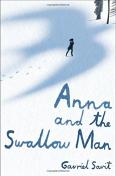
by Gavriel Savit
Hardcover- $11.38
A New York Times Bestseller
A Publishers Weekly Best Book of the Year
A Shelf Awareness Best Book of the Year
A Bulletin Blue Ribbon Book
...
Overall rating:
How would you rate this book?
Member ratings
This is the loveliest story about the most unlovely subject. Why is this book designated for grades seven and up? The message is more profound than what is perceived initially on its surface. This is a tale about evil that is witnessed through the eyes of a child and is far more accurately seen in that way, than through the eyes of an adult with the ability to alter and shape it to suit his ability to understand and cope with it. A child sees it without the decorations an adult often surrounds it with to make it more acceptable. A child simply sees the idea for what it is, evil incarnate; good and bad are simple concepts, one is to be sought and one is to be avoided. Anna is a child who possesses the wisdom of a far older person; she has the innocence of a child, but she also has the ability to interpret what she sees before her with simple clarity, without the need for a prettier package to soften the impact of what exists around her. She detects good and evil. Of necessity, she learns to survive.
It is 1939; Germany has marched into and conquered Poland. Anna is 7 years old when her father fails to return home, and she is unexpectedly abandoned by a close family friend who had been watching her in her father’s absence. She finds herself suddenly alone in Krakow, Poland, during a time of war. Unable to get into her apartment without a key, she returns to the family friend who left her, and outside his shop, becomes acquainted with “the Swallow Man”. Who is this Swallow Man? He becomes her protector and she becomes his ward. Their symbiotic relationship develops slowly as they wander through forest and field, searching for sustenance and safety. He teaches her how to survive and she teaches him how to feel in ways he seems to have forgotten.
Although the Holocaust is never really directly confronted, the horror and fear it invoked is clearly represented by the narrative and behavior of the characters. There is an absence of laughter and birdsong except at special moments. There is an evident war against Jews, but it is more hinted at than elucidated. The presence of fear and the threat of death as well as the feeling of cold and hunger are always simmering on the surface. The simple description of Bears and Wolves, both as predators who are to be feared for different reasons, paints the picture of the enemies they face, who are not only the Germans, but also are the Russians. There are few friends, and danger is ever present in the animal form, while birds often foreshadow safety.
This little book could be a wonderful tool to teach children about the nature of enemy vs. friend, compassion vs. indifference, survival vs. death, good vs. evil. It is a gentle, subtle, almost poetic presentation of the nature and horror of war, of the inanity and danger of prejudice, in a palatable way. The Holocaust becomes accessible in this book without the horrific descriptions usually used to offer information and instruction about a subject that remains a blight on the history of the world. It offers an opportunity to discuss and understand the event without the blood and gore which often prohibits its free discussion. The book should transcend the age limit for which it was recommended because it is appropriate for all ages.
Because I had both a print and audio of the book, I listened to and read it. Both versions were worthwhile. The narrator, Allan Corduner, was excellent when portraying each character, getting into their minds and attitudes with utter authenticity, forcing the reader to share their experiences.
Book Club HQ to over 90,000+ book clubs and ready to welcome yours.
Get free weekly updates on top club picks, book giveaways, author events and more








